Watch a video about iguanas, our lifeform of the week!
Iguanas are reptiles that resemble miniature dinosaurs. Did you know they can change colors or detach their tails? Or that iguanas have a third eye? Read on to discover more cool facts about these curious animals.
Meet the iguanas
Iguanas are reptiles that measure between 20 inches (50 cm) and 80 inches (2 m) long from head to tail. Their hind legs are considerably larger than their front legs. But on all four legs, they have quite strong claws that allow them to climb trees without falling. Plus, they can survive falls up to 50 feet (15 m) high. This ability is important because they live among tree branches.
In fact, despite their formidable appearance and sharp teeth, iguanas are herbivorous, or plant eaters. They feed mainly on leaves, flowers and fruits. Much of their water intake comes from the plants and flowers they eat. And no, they don’t eat insects. These reptiles usually live between 10 to 20 years.
These cold-blooded animals need heat and sun to survive. That’s why they usually live in temperate or hot climates and love to sunbathe. Furthermore, sunbathing is not a whim but a necessity. Among other things, sunlight gives iguanas the vitamin D they need to absorb enough calcium.
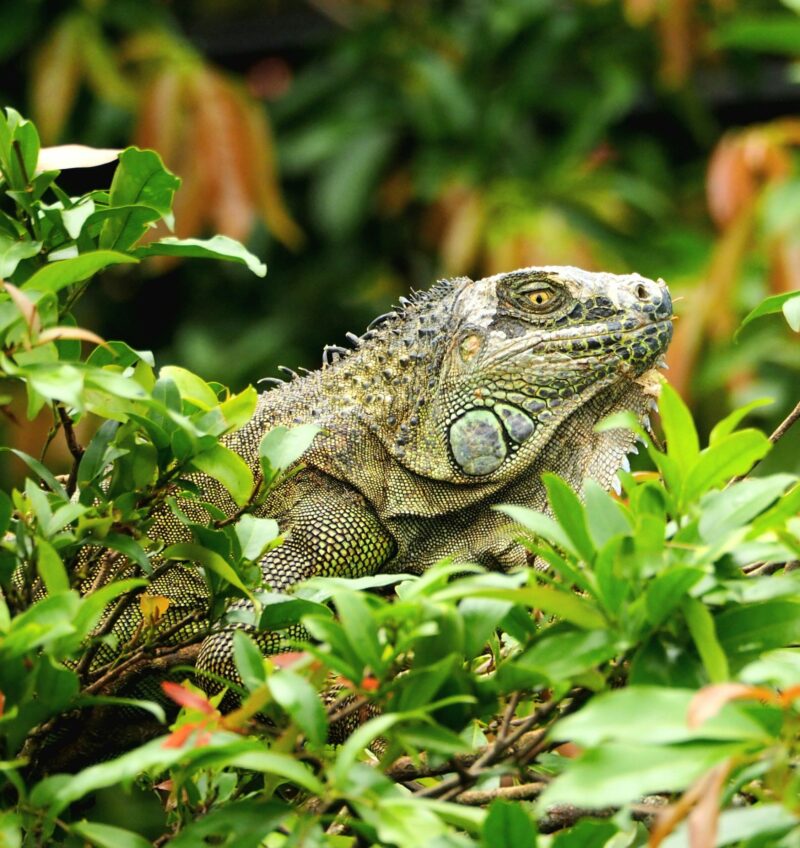
Anatomy
The extra skin under an iguana’s head is called the dewlap. It helps regulate an iguana’s temperature. And the spikes on the back and tail function as a solar collector that provides a greater surface area for absorbing heat and ultraviolet rays. Thus, iguanas stay warm longer and more effectively.
These reptiles have incredible eyesight that allow them to see colors, shadows and shapes from a long distance. In turn, that helps them anticipate predators, since their hearing is not the best. And they have well-developed lungs and breathe air just like humans.
Iguanas have a longer middle digit on their hind legs, which they use to climb trees. And they can use the tail for defense, to swim or as a stabilizer when jumping or climbing trees. In fact, iguanas are excellent swimmers. It’s hard to believe, but there are marine iguanas capable of diving for almost half an hour. These iguanas have the ability to forage in the sea for algae, which makes up almost all their diet.
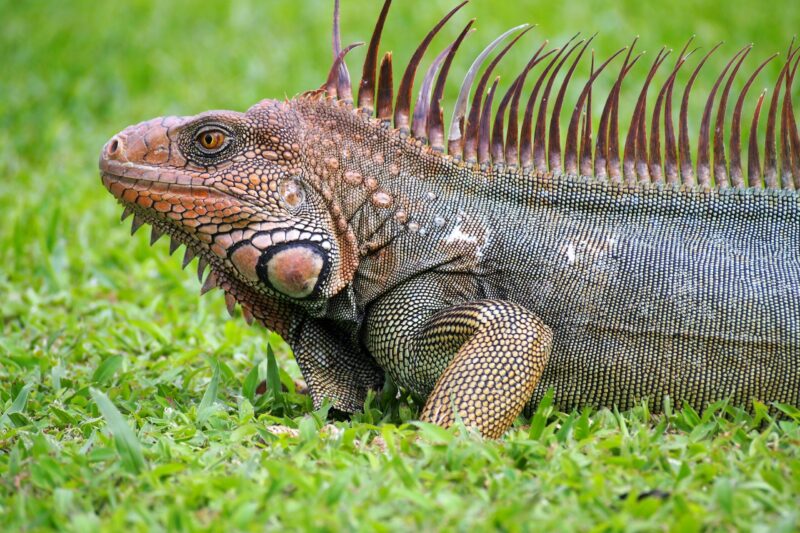
Colors
Iguanas have skin covered in small scales with the ability to change color. They use this ability to blend in with their environment and to hide from their predators. For example, the females can then go unnoticed when pregnant. But they can also change color to attract attention during heat. If an iguana is stressed or sick, it will change its color to dark shades.
You can find iguanas with a multitude of colors such as green, orange, yellow, purple, blue, white, black and red. And there are iguanas that have a combination of colors.
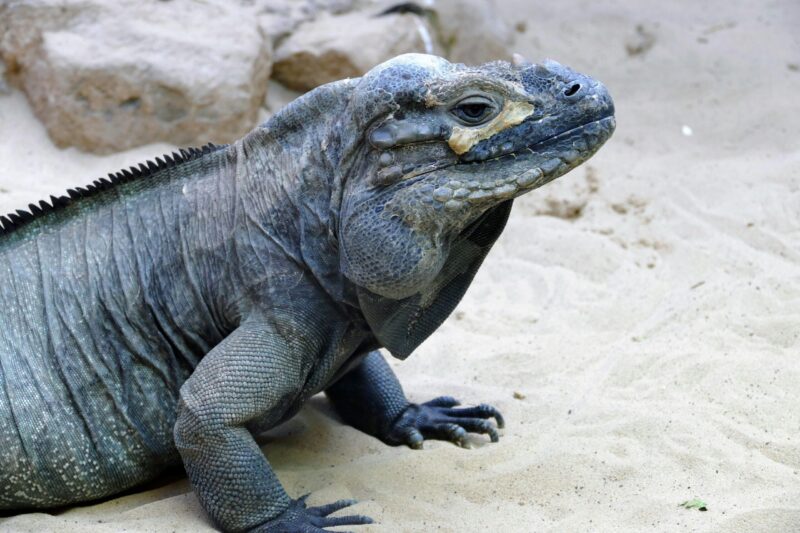

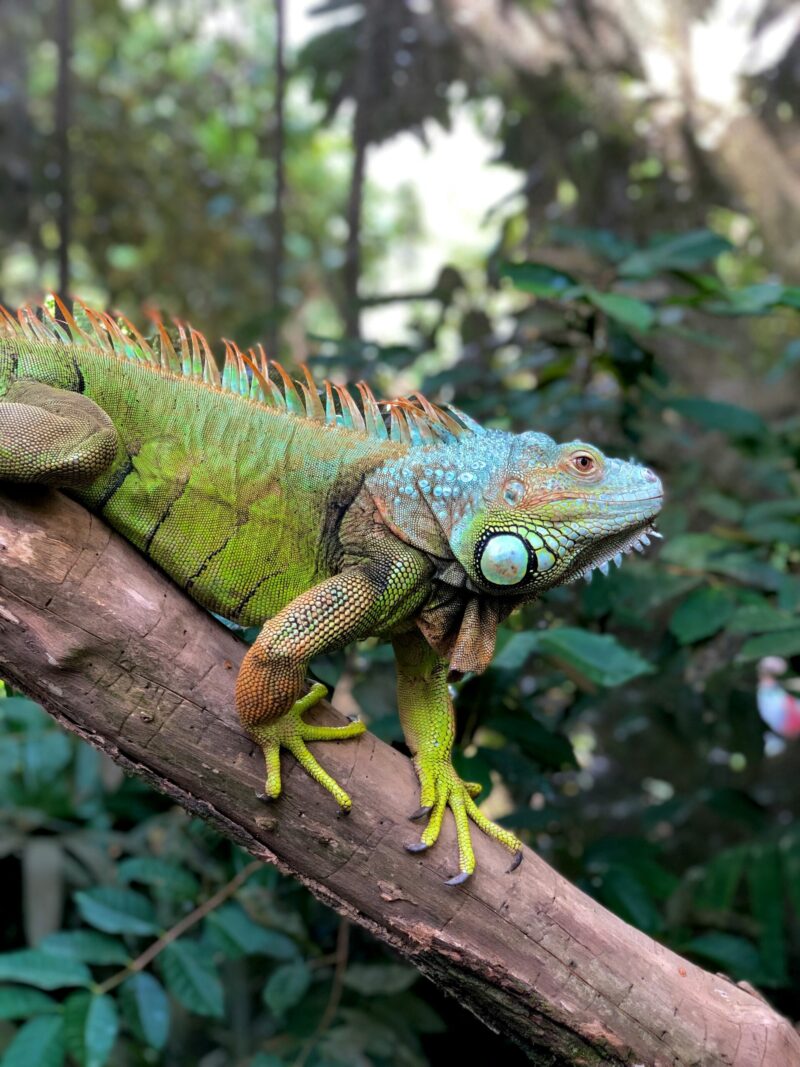
Skin and tail
Between the hard scales iguanas have quite flexible skin. Therefore, they have both protection and agility. Additionally, iguanas shed their skin.
Iguanas can detach their own tail. This is a defense mechanism called caudal autotomy that many lizards have. When a predator chases or catches them, these animals have the ability to get rid of their tail. Would you believe the tail remains moving for a few minutes on the ground or in the predator’s mouth? This distraction allows the lizard to escape.
Their tails come off, but they can also regenerate them. The new tail grows at a rate of approximately 0.2 inches (0.5 cm) per day. But it won’t be the same as the original tail. The texture is rougher and also has a more opaque color than the original. The new tail is shorter and the scales are smaller and irregularly placed. In fact, the ridge of spines on iguanas won’t regenerate. And if there is any color pattern or drawing, it is generally altered.
Iguanas have various fat reserves in their body, and one of them is the tail, which functions as both an energy reserve and to produce some hormones that function for their reproduction. So, although they can detach their tail, it’s best that this doesn’t happen, since infections can also occur until the wound heals.

The third eye
Just like in Lord of the Rings, iguanas also have an all-seeing eye. Just kidding, it doesn’t see it all! But it is true that in addition to their two regular eyes, iguanas have a third eye located on the top of their head. It’s known as parietal eye. And iguanas use them to more accurately detect prey and predators approaching from above. Many amphibians also possess this third eye.
This organ is a modified scale that functions as a light receptor to detect some predators. It can even help the animal know what time of year it is and regulate some physiological processes such as reproduction.
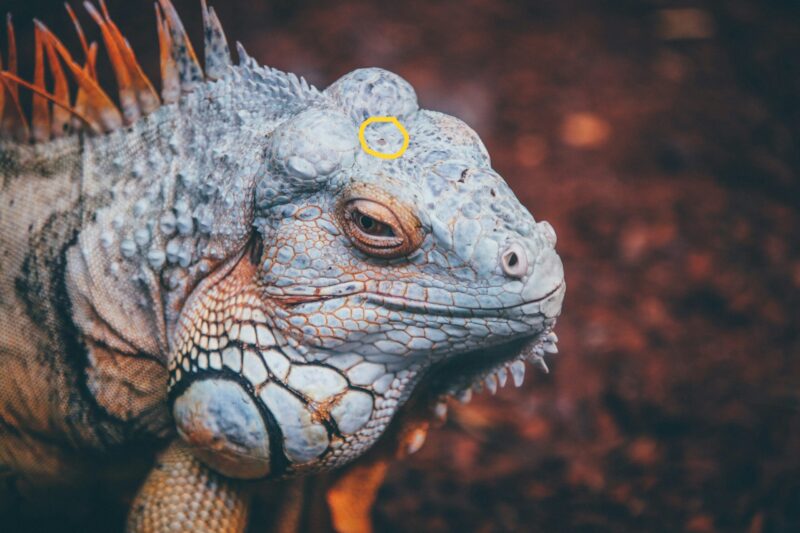
Behavior of iguanas
Iguanas are solitary animals; they only get together in groups during mating seasons. During this time, a group of females gathers around a single male.
Something very curious about iguanas is their courtship method. In this process, male iguanas move their head (and dewlap) up and down as if to say “Yes, I mean you,” while moving their tail to attract the attention of the females.
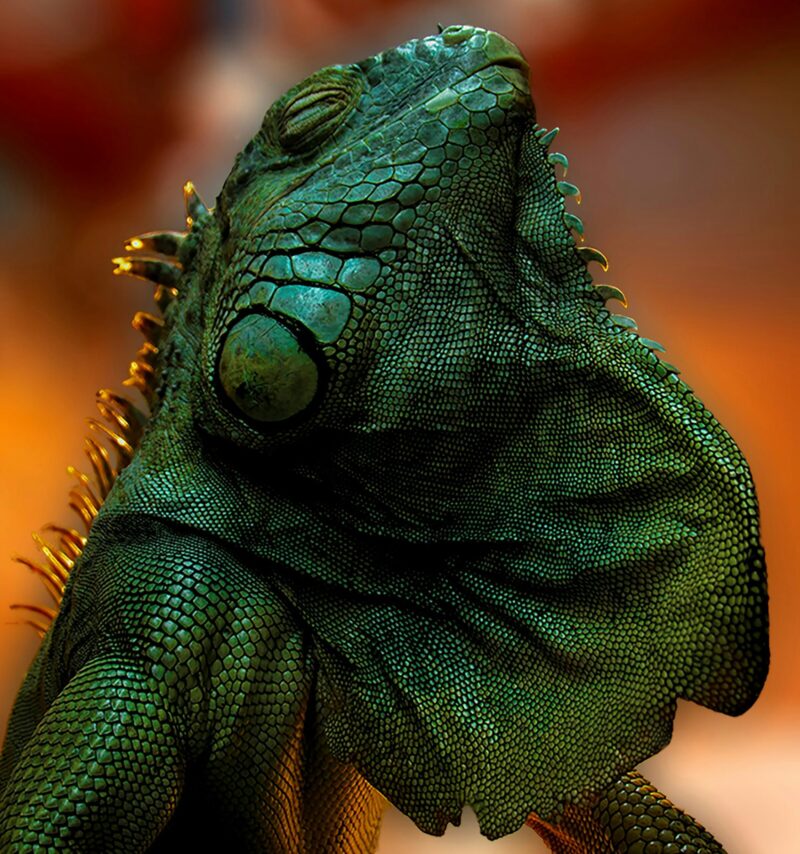
Although they prefer to live among tree branches, you can also see iguanas on land and in water. During the gestation period, females dig very deep tunnels to deposit their eggs and keep them safe from predators. The tunnels can measure up to 80 inches (2 meters) deep. Although they lay between 20 and 60 eggs, not all of them hatch. Some species can lay up to 80 eggs.
Iguanas are very calm animals, except during mating seasons, when males are more territorial. If they are not used to human contact, they can be a little aggressive. In fact, they use their tail as a defensive weapon to whip their enemies. But they won’t use it if you don’t approach them, because iguanas are skittish animals that prefer to run away and avoid problems.
When iguanas are adults, you can easily distinguish their sex. Males are much larger and more robust than females. In addition, males have more developed structures, such as the femoral pores and frontal lobes (the big protuberances under each side of their mouths).
Iguanas can communicate with each other in many ways. The most interesting is through pheromones that are released thanks to the femoral pores. These are modified scales found on the thighs of iguanas. The rubbing of the pores on the ground leaves aromas that alert other iguanas to the presence of a dominant male or female.
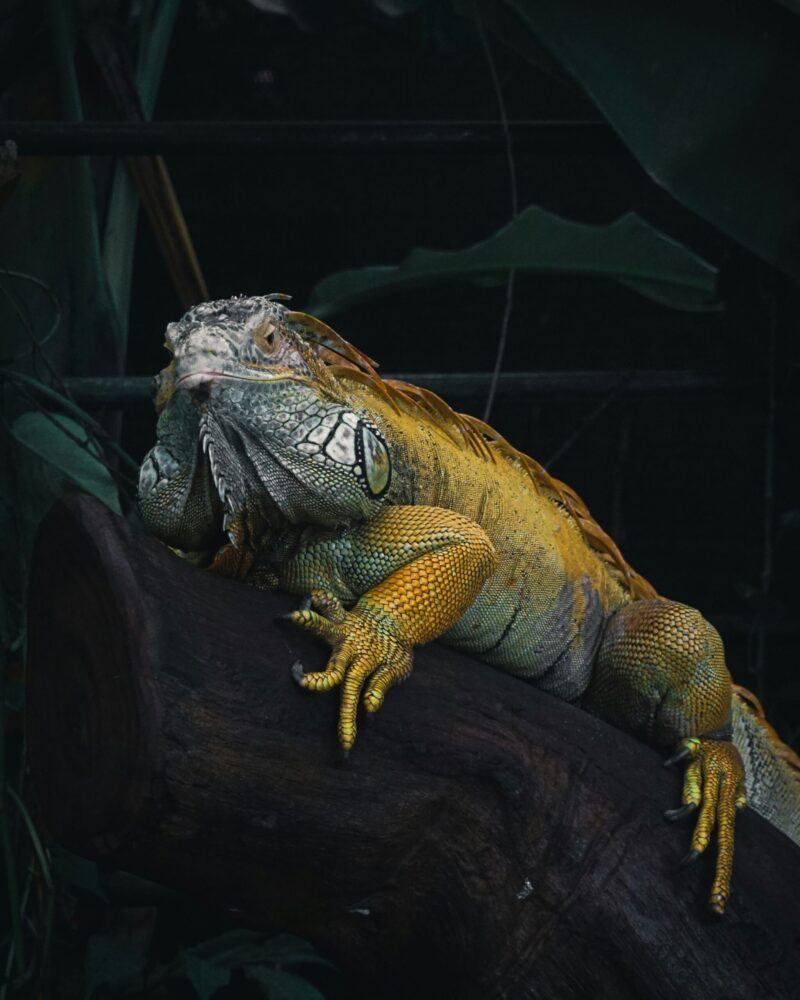
The history of iguanas
The first formal record of iguanas was in 1768, in a book by the Austrian zoologist and naturalist Nicolaus Laurenti. However, it is estimated that iguanas have lived on Earth for a long, long time. Iguana fossils have been found that date back about 75 million years, meaning that they lived in the Cretaceous period in South America.
But, although both iguanas and dinosaurs are reptiles, they belong to reptile branches distant from each other, so iguanas don’t descend from dinosaurs, even though the may look like mini versions of dinos!
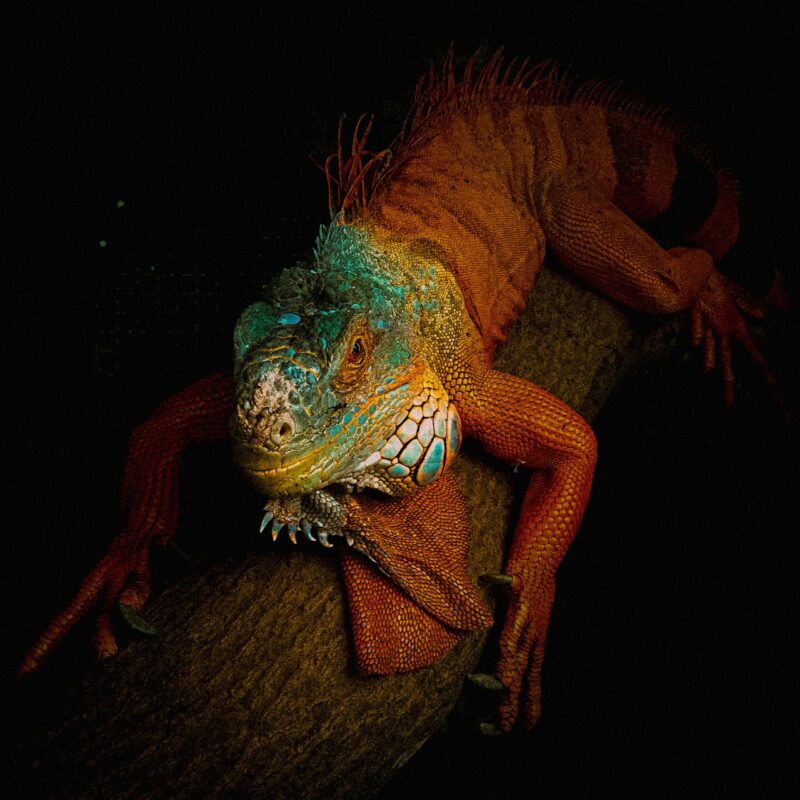
Bottom line: Iguanas are formidable, armored reptiles that can change color and detach their tails. Plus, they have a third eye! All you need to know about iguanas, here.
Read more lifeform of the week articles
The post Colorful iguanas are our lifeform of the week first appeared on EarthSky.
from EarthSky https://ift.tt/Ku4qfZW
Watch a video about iguanas, our lifeform of the week!
Iguanas are reptiles that resemble miniature dinosaurs. Did you know they can change colors or detach their tails? Or that iguanas have a third eye? Read on to discover more cool facts about these curious animals.
Meet the iguanas
Iguanas are reptiles that measure between 20 inches (50 cm) and 80 inches (2 m) long from head to tail. Their hind legs are considerably larger than their front legs. But on all four legs, they have quite strong claws that allow them to climb trees without falling. Plus, they can survive falls up to 50 feet (15 m) high. This ability is important because they live among tree branches.
In fact, despite their formidable appearance and sharp teeth, iguanas are herbivorous, or plant eaters. They feed mainly on leaves, flowers and fruits. Much of their water intake comes from the plants and flowers they eat. And no, they don’t eat insects. These reptiles usually live between 10 to 20 years.
These cold-blooded animals need heat and sun to survive. That’s why they usually live in temperate or hot climates and love to sunbathe. Furthermore, sunbathing is not a whim but a necessity. Among other things, sunlight gives iguanas the vitamin D they need to absorb enough calcium.

Anatomy
The extra skin under an iguana’s head is called the dewlap. It helps regulate an iguana’s temperature. And the spikes on the back and tail function as a solar collector that provides a greater surface area for absorbing heat and ultraviolet rays. Thus, iguanas stay warm longer and more effectively.
These reptiles have incredible eyesight that allow them to see colors, shadows and shapes from a long distance. In turn, that helps them anticipate predators, since their hearing is not the best. And they have well-developed lungs and breathe air just like humans.
Iguanas have a longer middle digit on their hind legs, which they use to climb trees. And they can use the tail for defense, to swim or as a stabilizer when jumping or climbing trees. In fact, iguanas are excellent swimmers. It’s hard to believe, but there are marine iguanas capable of diving for almost half an hour. These iguanas have the ability to forage in the sea for algae, which makes up almost all their diet.

Colors
Iguanas have skin covered in small scales with the ability to change color. They use this ability to blend in with their environment and to hide from their predators. For example, the females can then go unnoticed when pregnant. But they can also change color to attract attention during heat. If an iguana is stressed or sick, it will change its color to dark shades.
You can find iguanas with a multitude of colors such as green, orange, yellow, purple, blue, white, black and red. And there are iguanas that have a combination of colors.



Skin and tail
Between the hard scales iguanas have quite flexible skin. Therefore, they have both protection and agility. Additionally, iguanas shed their skin.
Iguanas can detach their own tail. This is a defense mechanism called caudal autotomy that many lizards have. When a predator chases or catches them, these animals have the ability to get rid of their tail. Would you believe the tail remains moving for a few minutes on the ground or in the predator’s mouth? This distraction allows the lizard to escape.
Their tails come off, but they can also regenerate them. The new tail grows at a rate of approximately 0.2 inches (0.5 cm) per day. But it won’t be the same as the original tail. The texture is rougher and also has a more opaque color than the original. The new tail is shorter and the scales are smaller and irregularly placed. In fact, the ridge of spines on iguanas won’t regenerate. And if there is any color pattern or drawing, it is generally altered.
Iguanas have various fat reserves in their body, and one of them is the tail, which functions as both an energy reserve and to produce some hormones that function for their reproduction. So, although they can detach their tail, it’s best that this doesn’t happen, since infections can also occur until the wound heals.

The third eye
Just like in Lord of the Rings, iguanas also have an all-seeing eye. Just kidding, it doesn’t see it all! But it is true that in addition to their two regular eyes, iguanas have a third eye located on the top of their head. It’s known as parietal eye. And iguanas use them to more accurately detect prey and predators approaching from above. Many amphibians also possess this third eye.
This organ is a modified scale that functions as a light receptor to detect some predators. It can even help the animal know what time of year it is and regulate some physiological processes such as reproduction.

Behavior of iguanas
Iguanas are solitary animals; they only get together in groups during mating seasons. During this time, a group of females gathers around a single male.
Something very curious about iguanas is their courtship method. In this process, male iguanas move their head (and dewlap) up and down as if to say “Yes, I mean you,” while moving their tail to attract the attention of the females.

Although they prefer to live among tree branches, you can also see iguanas on land and in water. During the gestation period, females dig very deep tunnels to deposit their eggs and keep them safe from predators. The tunnels can measure up to 80 inches (2 meters) deep. Although they lay between 20 and 60 eggs, not all of them hatch. Some species can lay up to 80 eggs.
Iguanas are very calm animals, except during mating seasons, when males are more territorial. If they are not used to human contact, they can be a little aggressive. In fact, they use their tail as a defensive weapon to whip their enemies. But they won’t use it if you don’t approach them, because iguanas are skittish animals that prefer to run away and avoid problems.
When iguanas are adults, you can easily distinguish their sex. Males are much larger and more robust than females. In addition, males have more developed structures, such as the femoral pores and frontal lobes (the big protuberances under each side of their mouths).
Iguanas can communicate with each other in many ways. The most interesting is through pheromones that are released thanks to the femoral pores. These are modified scales found on the thighs of iguanas. The rubbing of the pores on the ground leaves aromas that alert other iguanas to the presence of a dominant male or female.

The history of iguanas
The first formal record of iguanas was in 1768, in a book by the Austrian zoologist and naturalist Nicolaus Laurenti. However, it is estimated that iguanas have lived on Earth for a long, long time. Iguana fossils have been found that date back about 75 million years, meaning that they lived in the Cretaceous period in South America.
But, although both iguanas and dinosaurs are reptiles, they belong to reptile branches distant from each other, so iguanas don’t descend from dinosaurs, even though the may look like mini versions of dinos!

Bottom line: Iguanas are formidable, armored reptiles that can change color and detach their tails. Plus, they have a third eye! All you need to know about iguanas, here.
Read more lifeform of the week articles
The post Colorful iguanas are our lifeform of the week first appeared on EarthSky.
from EarthSky https://ift.tt/Ku4qfZW

Aucun commentaire:
Enregistrer un commentaire